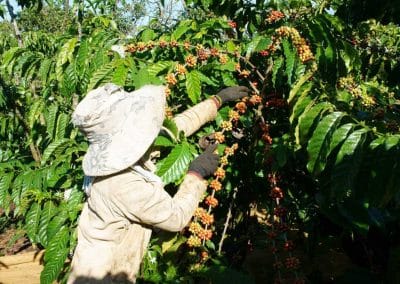Introduction to the World of Coffee The world of coffee is a vast and fascinating one, with a global popularity that is unmatched. This beloved beverage has a rich history that dates back centuries, and its cultivation and consumption have shaped economies and societies around the world. It is estimated that around 400 billion cups of coffee are consumed each year, making it one of the most consumed beverages worldwide and a cornerstone of daily rituals in many cultures.
Coffee is grown in various regions around the world, each with its own unique flavor profile due to variations in climate, altitude, soil composition, and processing methods. This diversity in coffee origins contributes to the wide range of flavors and aromas that coffee lovers can enjoy. Exploring the different coffee growing regions and their flavor profiles can help coffee enthusiasts narrow down their preferences and discover new and exciting taste experiences.
The Coffee Belt: An Overview
The majority of the world’s coffee is grown in an equatorial zone known as the “Bean Belt”. This region stretches between the Tropic of Cancer and the Tropic of Capricorn and encompasses Central and South America, Africa, and Southeast Asia. The Bean Belt’s climate and geographical location provide ideal conditions for coffee growth, with a consistent tropical climate and rich, fertile soils.
These regions are characterized by their high altitudes, volcanic landscapes, and tropical climates – all of which are conducive to growing high-quality coffee beans. In addition to climate and location, factors like soil composition, altitude, and processing methods also contribute to the unique flavor profiles of coffee from different regions. For example, coffee from high-altitude regions tends to have a more acidic and complex flavor, while coffee grown in volcanic soil may have unique mineral notes. The processing methods, such as wet or dry processing, also impact the flavor characteristics of the coffee beans.
Coffee Regions and Their Unique Characteristics
Central and South American Coffee
Coffee from Central and South America is celebrated for its well-rounded flavors, medium body, and pleasant acidity. These coffees often exhibit notes of chocolate, nuts, and caramel, which contribute to their overall smooth and balanced profile. Countries like Colombia, Costa Rica, and Guatemala are recognized for producing some of the best Central American coffees. Each country offers its own unique set of flavor characteristics.
Brazil, in particular, is a major coffee producer in South America, and its vast size and varied landscape allow for a wide range of coffee profiles. Brazilian coffees are generally known for their nutty and sweet flavors with a full body and low acidity, making them excellent for espresso blends.
African and Middle Eastern Coffee
African coffee is characterized by its vibrant flavors and distinct acidity. Many coffees from this region exhibit sweet, fruity, and delicate floral aromas. They are known for their bright and winey acidity, which is often balanced with sweet berry or citrus notes. Countries like Kenya and Ethiopia are particularly revered for their coffee production, each offering unique flavor nuances.
Yemen, located in the Middle East, has a rich coffee history and produces coffee beans with similar attributes to Ethiopian coffee beans. Yemeni coffee is known for its complex flavor profile. It is often characterized by notes of dried fruit, spices, and a distinctive wine-like acidity.
Asian Coffee
Southeast Asian coffees, such as those from Indonesia and Vietnam, have distinct characteristics that set them apart from other coffee-growing regions. Indonesian coffees are often full-bodied and earthy, with flavors of dark chocolate, earth, and herbs. These coffees are typically low in acidity, with a heavy body and a lingering finish.
Vietnamese coffees, on the other hand, are milder and often exhibit a delicate balance of sweet and savory notes. The country is also the world’s second-largest producer of Robusta coffee. It is a variety known for its strong, bitter flavor and high caffeine content. Regions like Sumatra, Laos, and Vietnam are known for producing exceptional coffee beans with unique taste profiles.
Exploring Coffee Flavors: The Influence of Origin and Processing
Coffee flavor is influenced by a myriad of factors. It includes the origin of the coffee beans and the processing methods used. Factors that contribute to the flavor profile of coffee include:
- Soil chemistry: The mineral content of the soil can greatly affect the taste of the coffee. For instance, coffee grown in volcanic soil may have a distinct mineral flavor.
- Weather conditions: The amount of rainfall, sunlight, and the overall climate can influence a coffee’s flavor profile. Coffee grown in regions with a wet, tropical climate often has a fruitier flavor.
- Altitude: Coffee grown at higher altitudes tends to mature slower, resulting in a denser bean and a more acidic and complex taste.
- Processing methods: The way the coffee cherries are processed after harvest can greatly influence the flavor of the coffee. Wet processing tends to produce a cleaner and brighter cup. While dry processing can result in a fruitier and more wine-like flavor.
Additionally, the choice of coffee varieties, such as Arabica or Robusta, further contributes to the diversity of coffee flavors. Arabica beans are generally seen as the higher-quality variety, known for their smooth, delicate flavors and lower caffeine content. On the other hand, Robusta beans are more robust in flavor, with a stronger bitterness and higher caffeine content.
Delving into Coffee Varieties: From Arabica to Robusta
There are two main species of coffee plants: Coffea arabica and Coffea canephora (Coffea robusta). These species give rise to different coffee bean varieties, each with its own unique flavor characteristics. Varieties like Typica, Bourbon, and Geisha are highly sought after by coffee enthusiasts for their distinct taste experiences.
The processing method used for coffee beans, such as washed, natural, or honey processing, also influences the flavor profile. Each processing method brings out different flavor notes and characteristics in the beans. This allows for a wide range of taste experiences for coffee lovers. For instance, washed coffees are typically clean and bright, with a clear expression of origin. While natural processed coffees can be fruity, sweet, and complex.
The Cultural Significance of Coffee Names and Origins
Coffee bean names often reflect their origins and carry cultural significance. For example, names like “Java,” “Mocha,” and “Arabian coffee” all have historical and cultural associations with specific regions. These names are not just marketing gimmicks, but a testament to the rich history and cultural significance of coffee.
Specialty coffee bean names, such as Ethiopian Yirgacheffe, Colombian Supremo, and Jamaican Blue Mountain, go beyond geographical origins. They often indicate meticulous cultivation and processing methods that result in exceptional quality. These names are a testament to the dedication and hard work of the coffee farmers and processors. They often command a premium in the market due to their superior quality and unique flavor profiles.
Coffee companies leverage these bean names in their branding and marketing strategies to create a strong presence in the industry and differentiate themselves from competitors. By using storytelling, imagery, and packaging design, coffee brands enhance the appeal of specific beans and create a unique identity for their products. This not only helps them stand out in a crowded market, but also communicates the values and story behind their brand.
Sustainable and Responsible Coffee Farming
Sustainable coffee farming practices are crucial for the long-term viability of the coffee industry. Also the well-being of coffee farmers and their communities. With climate change posing a significant threat to coffee production, there is a growing need for sustainable and resilient farming practices. Nestle, for example, is committed to sustainable coffee sourcing and supports responsible farming methods.
The company collaborates with non-profit organizations, industry experts, and governmental bodies to advance sustainable coffee practices. This includes implementing practices that preserve biodiversity, reduce water usage, and mitigate the impact of climate change. Nestle also prioritizes the livelihoods of coffee farmers by providing training and resources for sustainable cultivation practices.
In addition to environmental sustainability, Nestle also seeks to ensure social and economic sustainability. They actively seek certifications such as Rainforest Alliance and Fairtrade to ensure environmental and social standards are met. These certifications promote fair labor practices, safe working conditions, and equitable trade terms for farmers. By investing in projects that enhance farmers’ livelihoods and empower local communities, Nestle contributes to the economic development of coffee-growing regions.
Economic Impact of the Coffee Industry
The coffee industry has a significant economic impact on different regions around the world. Coffee production provides livelihoods for millions of farmers and plays a crucial role in the economies of many coffee-growing countries. The income generated from coffee production supports local communities by improving access to education, healthcare, and other essential services.
Companies like Nestle understand the importance of supporting coffee farmers and invest in projects that enhance their livelihoods. By promoting sustainable farming practices and ensuring fair trade, Nestle contributes to the economic well-being of coffee farmers and helps create a more equitable coffee industry. Their commitment to sustainability and fair trade not only benefits the farmers, but also ensures the continued availability of high-quality coffee for consumers around the world.








